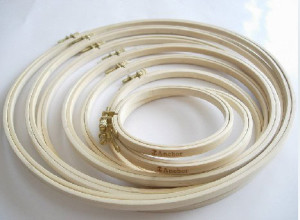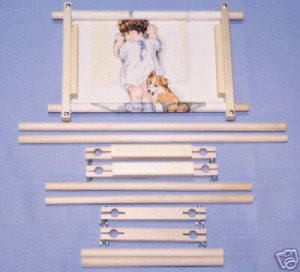Cross Stitch Frames and Hoops
Cross stitch frames and hoops were developed to provide cross stitchers with an easy way to stitch their projects. Although some people prefer to hold the fabric in their hand while stitching, which may lead to a great deal of frustration, embroidery hoops and tapestry frames allow the stitcher to keep an even stitch tension during cross stitching. Hoops and frames keep the fabric taut and allow easier handling while stitching.
Cross Stitch Hoops
The most popular cross stitch frames for use with small areas of cross stitch are hoops. Cross stitch hoops are comprised of two rings, an inner hoop and an outer hoop, with one fitted inside the other. The outer ring usually has an adjustable screw attachment so that it can be tightened to hold the stretched fabric in place. Usually these hoops are wooden but they are also available in plastic, or a combination of plastic and metal. Popular sizes are 4″, 6″, 8″, 10″ and 12″ diameter. Hoops with table stands or floor stands attached are also available.
Using an Cross Stitch Hoop
To stretch your fabric in a hoop, place the area to be cross stitched over the inner ring and press the outer ring over it, with the tension screw at the top out of the way and released. Tissue paper can be placed between the outer ring and the cross stitch, so that the hoop does not mark the fabric. Lay the tissue paper over the fabric when you set it in the hoop, then tear away the central area that is over the cross stitch. Tighten the tension screw, adjusting the fabric so that it is taut as a drum. If the fabric creases, release the outer hoop and try again. Smooth the fabric and, if necessary, straighten the grain before tightening the screw. Check that the horizontal and vertical threads have not been distorted in the process. The fabric should be evenly stretched.
Using a Flexi-Hoop: Flexi-hoops are circular or oval, plastic hoops which consist of a rigid inner hoop and a flexible outer hoop. The outer hoop is eased on to the inner hoop to hold work tautly in place. Flexi-hoops come in a variety of sizes, colours and finishes. Because they are available in very small sizes, they are often used instead of wooden embroidery hoops for working very small projects. When stitching is finished, the flexi-hoop can be used as a decorative frame for the completed work.
Embroidery hoops can have several disadvantages though. They often leave circular marks on the fabric and, as your work develops, the fabric has to be removed and re positioned, notably with larger designs. You should remove your work from the hoop when you are not working on them in order to avoid leaving any marks.
Cross Stitch Frames.
Many cross stitchers prefer frames, rather than hoops, for their cross stitching projects. Rectangular cross stitch frames are most suitable for larger pieces of cross stitch. The rotating or roller cross stitch frames are one of the most popular cross stitch frames for cross stitching. These cross stitch frames are gentler on the fabric compared to a hoop, causing less unsightly marks on the cloth and allowing for a much larger working area.
Rectangular cross stitch frames consist of two rollers, with tapes attached, and two flat side pieces, which slot into the rollers and are held in place by pegs or screw attachments. Available in different sizes, cross stitch frames are measured by the length of the roller tape, ranging from 12 inches (30 cm) to 27 inches (68 cm).
Using a frame for cross stitch, compared with an embroidery hoop, does have its advantages. The top of the fabric is secured to the upper bar, and the bottom to the lower bar. Cross stitch frames allow completed sections of larger projects to be rolled up so that the next section is ready for stitching. This way you don’t have to remove the fabric from the frame, like you may have to do when using an embroidery hoop in order to re position the cloth. Cross stitch frames also avoids the circular marks on the finished cross stitch project, which often result from handling the hoop.
Using an Cross Stitch Frame
If the cross stitch design you are working is too large to fit a hoop, use an embroidery frame. First, hem your fabric to strengthen the edges so that it will not pull apart when it is stitched to the frame.
Sew the top of the fabric to the top piece of the frame’s webbing and do the same at the bottom, matching the centre of the fabric to the centre of the webbing. Do not be tempted to use drawing pins or staples to attach the fabric – threads may be pulled which will ruin the fabric.
Stitch the sides of the fabric to the frame stretchers with strong threads and, when both sides are sewn, tighten the threads and the wing-nuts so that the fabric is stretched taut. Tie the ends of the threads firmly to the stretchers. When working a long design it may be necessary to roll completed stitching on to one of the rollers to expose more fabric for work. In this case a sheet of white tissue paper rolled into the back of the work will prevent crushing the stitches.
Cross stitch frames although a little more work to setup do offer quite a few advantages over cross stitch hoops for larger projects.
Recommended Reading
Looking for a good book to read? If your looking for a great reference book to help you out with answers to your cross stitching questions, or maybe your just looking for a present to give that loved one who is mad about cross stitch. Then head over to our books page where we have compiled a list of great books that no serious cross stitcher should be without.
Related Terms:
Cross Stitch Frames
Cross Stitch Hoops
Learn more about…
- How to Cross Stitch – General Guidelines
- Cross Stitch Fabrics
- Cross Stitch Thread or Floss
- Calculating How Much Cross Stitch Fabric To Buy
- Cross Stitch Needles
- Cross Stitch Frames and Hoops
- Cross Stitch Charts
- Cross Stitch for Beginners: Securing the edges, finding the centre of the fabric and preparing the thread
- Starting and Finishing a Cross Stitch Pattern
- Working Hem stitch
- Scoring and Stitching a Folded Hem
- Washing and Ironing Cross Stitch
- Stretching and Mounting Cross Stitch
- Framing Cross Stitch


